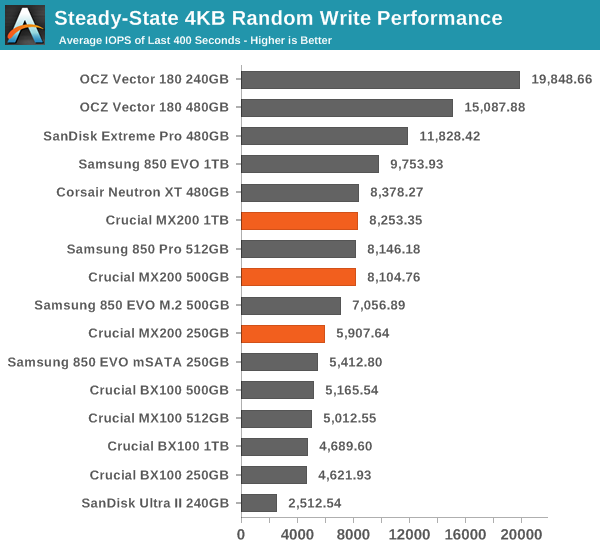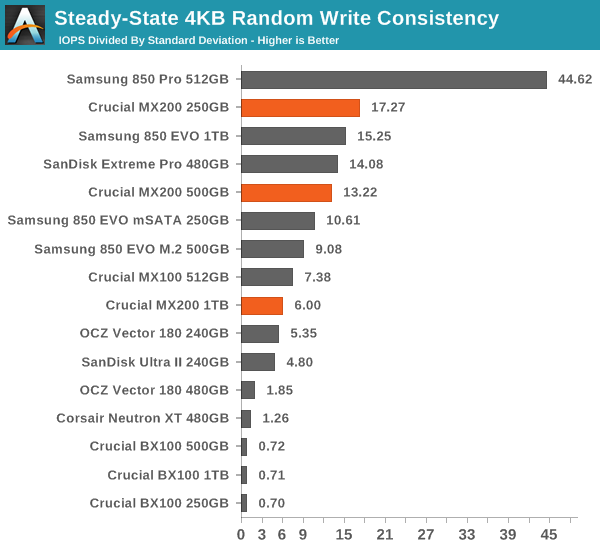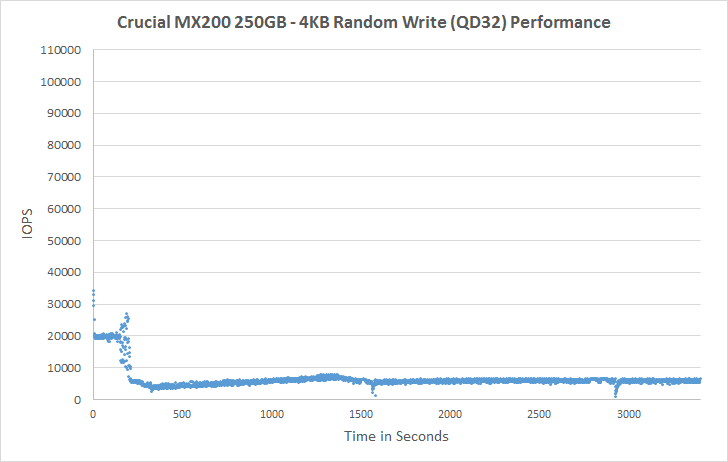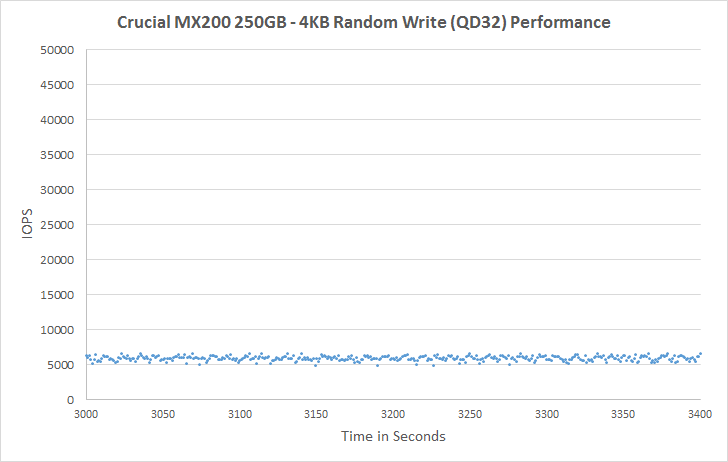Crucial MX200 (250GB, 500GB & 1TB) SSD Review
by Kristian Vättö on May 22, 2015 8:00 AM EST- Posted in
- Storage
- SSDs
- Crucial
- MX200
- Micron 16nm
Performance Consistency
We've been looking at performance consistency since the Intel SSD DC S3700 review in late 2012 and it has become one of the cornerstones of our SSD reviews. Back in the days many SSD vendors were only focusing on high peak performance, which unfortunately came at the cost of sustained performance. In other words, the drives would push high IOPS in certain synthetic scenarios to provide nice marketing numbers, but as soon as you pushed the drive for more than a few minutes you could easily run into hiccups caused by poor performance consistency.
Once we started exploring IO consistency, nearly all SSD manufacturers made a move to improve consistency and for the 2015 suite, I haven't made any significant changes to the methodology we use to test IO consistency. The biggest change is the move from VDBench to Iometer 1.1.0 as the benchmarking software and I've also extended the test from 2000 seconds to a full hour to ensure that all drives hit steady-state during the test.
For better readability, I now provide bar graphs with the first one being an average IOPS of the last 400 seconds and the second graph displaying the IOPS divided by standard deviation during the same period. Average IOPS provides a quick look into overall performance, but it can easily hide bad consistency, so looking at standard deviation is necessary for a complete look into consistency.
I'm still providing the same scatter graphs too, of course. However, I decided to dump the logarithmic graphs and go linear-only since logarithmic graphs aren't as accurate and can be hard to interpret for those who aren't familiar with them. I provide two graphs: one that includes the whole duration of the test and another that focuses on the last 400 seconds of the test to get a better scope into steady-state performance.

It looks like Crucial has finally taken steps to improve steady-state performance, although the additional over-provisioning is partially to thank for the increase. One criticism I always had about Crucial's SSDs was the relatively bad steady-state performance, but the MX200 finally brings the performance closer to other high-end drives.

The consistency is very good as well and far better than what the BX100 offers.
 |
|||||||||
The IO consistency appears to behave differently from the MX100 and the graph resembles 850 EVO and Pro quite a bit by dropping quickly in performance and then slowly increasing before evening out. The 1TB model is an exception, though, as it seems that the firmware can't properly handle such a large capacity, which results in worse performance and considerably higher variation. Unfortunately, the MX200 wouldn't respond to the hdparm command that I use for over-provisioning testing, so I don't have any results with added over-provisioning at this point.
 |
|||||||||










62 Comments
View All Comments
KAlmquist - Saturday, May 23, 2015 - link
Take another look at Anandtech Bench. At the 500GB capacity, the mx100 beats the m550 by a small amount across the board. Dropping down to the 250GB capacity affects the write speed of the mx100 more than the write speed of the m550, so the m550 outperforms the mx100 on some benchmarks, but not by a lot. The bottom line is that the m550 and mx100 are close enough in performance that I doubt you would notice any difference in real life usage.petar_b - Sunday, September 4, 2016 - link
I wish I know the answer to that question. I use plenty of M500 and M500, and I really miss them. I don't know if SanDisk could be decent alternative to M550, I don't know how additional features compare to each other (power loss, power management, etc etc). Is there any comprehensive comparison between Micron and SanDisk ??Devo2007 - Friday, May 22, 2015 - link
Small typo on page 3. Under the Destroyer (Data Rate) graph, it says the following:Despite the improved IO consistency, the MX200 doesn't have any advantage over the MX200 in our heaviest The Destroyer trace."
I'm not sure if you meant MX100 or BX100 the second time
XZerg - Friday, May 22, 2015 - link
same on the page 10 under the power consumption chart:but at ~60mW the MX200 enjoys a small benefit over the MX200
Ryan Smith - Friday, May 22, 2015 - link
Thanks. Fixed.Essence_of_War - Friday, May 22, 2015 - link
Yikes, not at all impressed with the DWA in the benchmark workloads! It seems like DWA is a highly dubious feature for a price mark-up over the BX series. At the right price point the larger capacity MX200 w/o DWA (500 and 1TB) still seem like excellent buys, they're just competing super-hard with their BX brethren.olafgarten - Friday, May 22, 2015 - link
I'm still waiting to see what SanDisk does this year.romrunning - Friday, May 22, 2015 - link
Thanks for the good review, Kristian. I liked the call-out on the continued lack of full power-loss protection, and I really liked the constructive criticism in your final words.Shadowmaster625 - Friday, May 22, 2015 - link
why would they even release a product with an slc cache when the slc cache clearly does absolutely nothing?hulu - Friday, May 22, 2015 - link
I'm sure the cache does *something* - mostly when you don't write large amounts of data for minutes on end.The problem with MX200 256GB's implementation is that Crucial is using too much of pseudo-SLC (all the space there is) and the drive ends up driving itself against the wall when the drive fills up. The drive still needs to keep up with the continuing drive writes and at the same time move existing data from SLC to MLC.